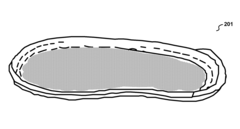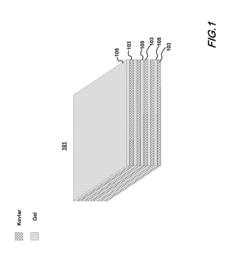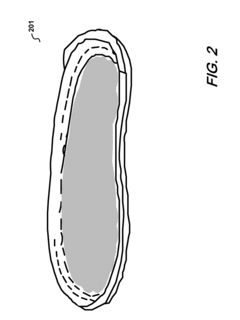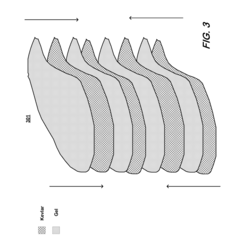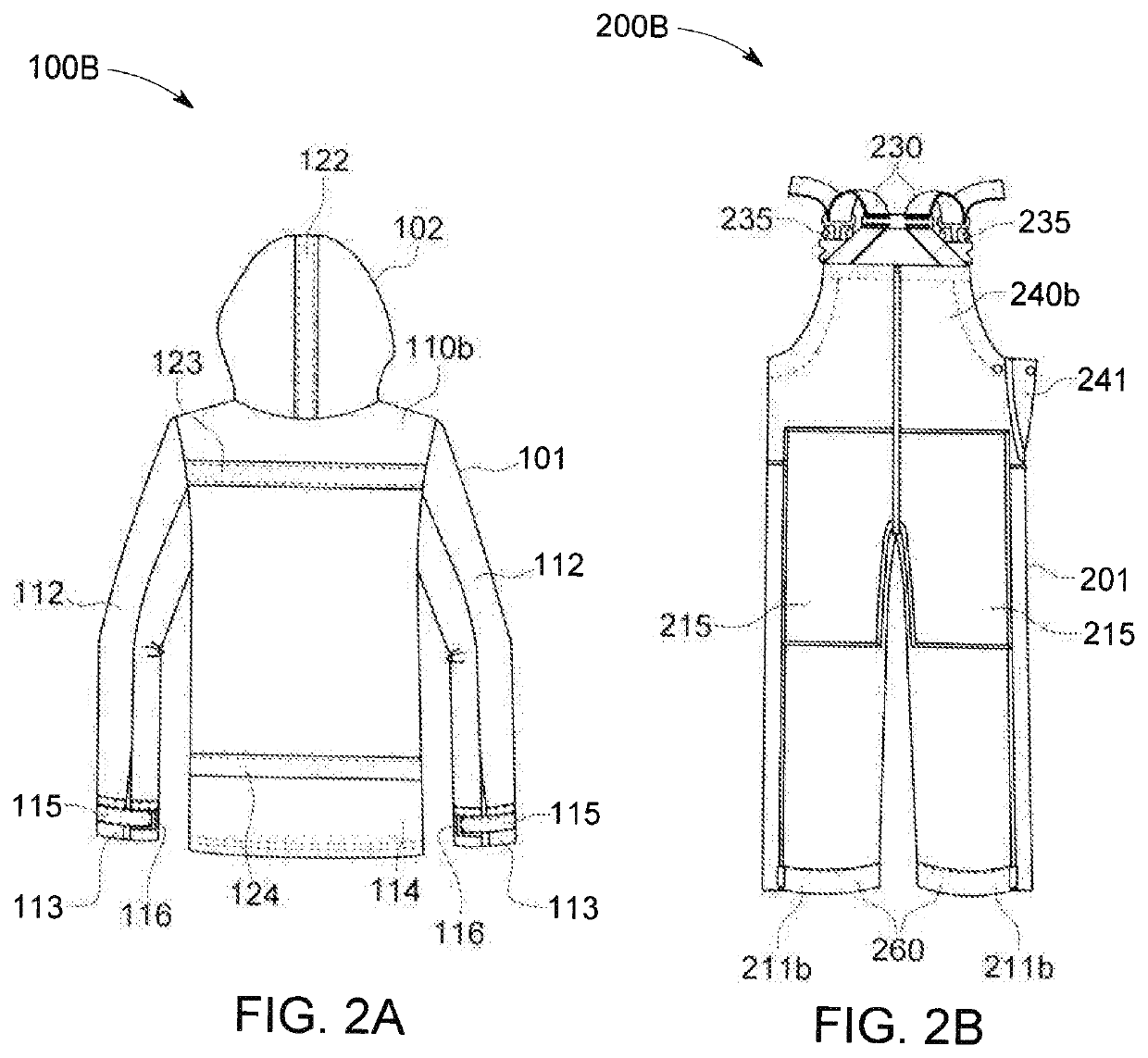How Kevlar Enhances Elasticity in Wear-Resistant Apparel?
JUL 10, 20259 MIN READ
Generate Your Research Report Instantly with AI Agent
Patsnap Eureka helps you evaluate technical feasibility & market potential.
Kevlar in Elasticity Enhancement: Background and Objectives
Kevlar, a high-strength synthetic fiber developed by DuPont in the 1960s, has revolutionized the field of protective apparel. Initially designed for use in tires, Kevlar's exceptional strength-to-weight ratio quickly led to its adoption in a wide range of applications, including body armor, aerospace components, and high-performance sportswear. The evolution of Kevlar's use in wear-resistant apparel represents a significant technological advancement in the pursuit of enhanced protection and comfort for users in various industries.
The primary objective of incorporating Kevlar into elastic wear-resistant apparel is to achieve an optimal balance between durability and flexibility. This combination addresses the longstanding challenge of creating protective gear that does not compromise the wearer's mobility or comfort. By enhancing elasticity in Kevlar-based fabrics, manufacturers aim to produce garments that can withstand extreme conditions while allowing for a full range of motion.
The development of Kevlar-enhanced elastic apparel has been driven by increasing demands from multiple sectors, including military, law enforcement, industrial workers, and extreme sports enthusiasts. These groups require clothing that can protect against abrasion, cuts, and impacts while maintaining the flexibility necessary for their activities. The technological goal is to create a material that combines Kevlar's strength with elastic properties, resulting in a fabric that can stretch and recover without losing its protective qualities.
Recent advancements in polymer science and textile engineering have paved the way for innovative approaches to integrating Kevlar into elastic fabrics. Researchers are exploring various methods, such as blending Kevlar fibers with elastic materials, developing new spinning techniques, and creating composite structures that leverage the unique properties of both Kevlar and elastic polymers. These efforts aim to overcome the inherent rigidity of traditional Kevlar fabrics while maintaining their superior protective characteristics.
The ongoing research in this field is focused on several key areas: improving the bonding between Kevlar and elastic materials, enhancing the overall elasticity of Kevlar-based fabrics without compromising strength, and developing manufacturing processes that can produce these advanced materials at scale. Additionally, there is a growing emphasis on creating sustainable and environmentally friendly solutions, as the durability of Kevlar-enhanced apparel contributes to reduced waste and longer product lifecycles.
As the technology continues to evolve, the potential applications for Kevlar-enhanced elastic wear-resistant apparel are expanding. Beyond traditional protective gear, these materials are finding use in high-performance athletic wear, medical textiles, and even fashion. The convergence of protection, comfort, and style is opening new markets and driving further innovation in the field.
The primary objective of incorporating Kevlar into elastic wear-resistant apparel is to achieve an optimal balance between durability and flexibility. This combination addresses the longstanding challenge of creating protective gear that does not compromise the wearer's mobility or comfort. By enhancing elasticity in Kevlar-based fabrics, manufacturers aim to produce garments that can withstand extreme conditions while allowing for a full range of motion.
The development of Kevlar-enhanced elastic apparel has been driven by increasing demands from multiple sectors, including military, law enforcement, industrial workers, and extreme sports enthusiasts. These groups require clothing that can protect against abrasion, cuts, and impacts while maintaining the flexibility necessary for their activities. The technological goal is to create a material that combines Kevlar's strength with elastic properties, resulting in a fabric that can stretch and recover without losing its protective qualities.
Recent advancements in polymer science and textile engineering have paved the way for innovative approaches to integrating Kevlar into elastic fabrics. Researchers are exploring various methods, such as blending Kevlar fibers with elastic materials, developing new spinning techniques, and creating composite structures that leverage the unique properties of both Kevlar and elastic polymers. These efforts aim to overcome the inherent rigidity of traditional Kevlar fabrics while maintaining their superior protective characteristics.
The ongoing research in this field is focused on several key areas: improving the bonding between Kevlar and elastic materials, enhancing the overall elasticity of Kevlar-based fabrics without compromising strength, and developing manufacturing processes that can produce these advanced materials at scale. Additionally, there is a growing emphasis on creating sustainable and environmentally friendly solutions, as the durability of Kevlar-enhanced apparel contributes to reduced waste and longer product lifecycles.
As the technology continues to evolve, the potential applications for Kevlar-enhanced elastic wear-resistant apparel are expanding. Beyond traditional protective gear, these materials are finding use in high-performance athletic wear, medical textiles, and even fashion. The convergence of protection, comfort, and style is opening new markets and driving further innovation in the field.
Market Analysis for Kevlar-Enhanced Elastic Apparel
The market for Kevlar-enhanced elastic apparel represents a significant growth opportunity within the broader technical textiles and performance wear sectors. This innovative combination of materials addresses the increasing demand for durable, flexible, and high-performance clothing across various industries and consumer segments.
In the sports and outdoor recreation market, Kevlar-enhanced elastic apparel offers superior protection and flexibility for activities such as mountaineering, rock climbing, and extreme sports. The growing popularity of adventure tourism and outdoor activities is driving demand for clothing that can withstand harsh environments while maintaining comfort and ease of movement.
The military and law enforcement sectors present another substantial market for Kevlar-enhanced elastic apparel. These industries require clothing that provides both ballistic protection and freedom of movement for personnel operating in high-risk environments. The ability to combine the strength of Kevlar with elasticity addresses a critical need in tactical gear and protective clothing.
Workwear and industrial safety apparel represent a third major market segment. Industries such as construction, manufacturing, and oil and gas exploration require clothing that offers both protection against workplace hazards and flexibility for improved worker comfort and productivity. Kevlar-enhanced elastic apparel meets these requirements, potentially reducing workplace injuries and improving overall safety compliance.
The motorcycle and automotive racing industries also show significant potential for Kevlar-enhanced elastic apparel. Riders and drivers require protective gear that offers both impact resistance and flexibility, making this innovative material combination ideal for racing suits, gloves, and other safety equipment.
Consumer demand for high-performance, multi-functional clothing is driving growth in the athleisure and activewear markets. Kevlar-enhanced elastic apparel can meet the needs of consumers seeking durable, stylish clothing that transitions seamlessly between various activities and environments.
Market trends indicate a growing awareness of sustainability and eco-friendly materials among consumers. While Kevlar itself is not biodegradable, its durability contributes to longer-lasting products, potentially reducing overall textile waste. Manufacturers exploring ways to incorporate recycled Kevlar or develop more sustainable production methods may gain a competitive edge in environmentally conscious market segments.
The global market for technical textiles, which includes Kevlar-enhanced elastic apparel, is expected to continue its growth trajectory. Factors such as increasing safety regulations, rising disposable incomes in emerging markets, and ongoing technological advancements in material science are likely to fuel this expansion across various geographic regions and industry sectors.
In the sports and outdoor recreation market, Kevlar-enhanced elastic apparel offers superior protection and flexibility for activities such as mountaineering, rock climbing, and extreme sports. The growing popularity of adventure tourism and outdoor activities is driving demand for clothing that can withstand harsh environments while maintaining comfort and ease of movement.
The military and law enforcement sectors present another substantial market for Kevlar-enhanced elastic apparel. These industries require clothing that provides both ballistic protection and freedom of movement for personnel operating in high-risk environments. The ability to combine the strength of Kevlar with elasticity addresses a critical need in tactical gear and protective clothing.
Workwear and industrial safety apparel represent a third major market segment. Industries such as construction, manufacturing, and oil and gas exploration require clothing that offers both protection against workplace hazards and flexibility for improved worker comfort and productivity. Kevlar-enhanced elastic apparel meets these requirements, potentially reducing workplace injuries and improving overall safety compliance.
The motorcycle and automotive racing industries also show significant potential for Kevlar-enhanced elastic apparel. Riders and drivers require protective gear that offers both impact resistance and flexibility, making this innovative material combination ideal for racing suits, gloves, and other safety equipment.
Consumer demand for high-performance, multi-functional clothing is driving growth in the athleisure and activewear markets. Kevlar-enhanced elastic apparel can meet the needs of consumers seeking durable, stylish clothing that transitions seamlessly between various activities and environments.
Market trends indicate a growing awareness of sustainability and eco-friendly materials among consumers. While Kevlar itself is not biodegradable, its durability contributes to longer-lasting products, potentially reducing overall textile waste. Manufacturers exploring ways to incorporate recycled Kevlar or develop more sustainable production methods may gain a competitive edge in environmentally conscious market segments.
The global market for technical textiles, which includes Kevlar-enhanced elastic apparel, is expected to continue its growth trajectory. Factors such as increasing safety regulations, rising disposable incomes in emerging markets, and ongoing technological advancements in material science are likely to fuel this expansion across various geographic regions and industry sectors.
Current Challenges in Wear-Resistant Elastic Fabrics
The development of wear-resistant elastic fabrics faces several significant challenges in the current landscape. One of the primary issues is achieving an optimal balance between durability and flexibility. Traditional wear-resistant materials often lack the necessary elasticity for comfortable, form-fitting apparel, while highly elastic fabrics tend to be less durable and prone to wear and tear.
Another challenge lies in maintaining the fabric's performance characteristics over time. Many elastic materials lose their stretch and recovery properties after repeated use or exposure to harsh environmental conditions. This degradation can significantly reduce the lifespan of wear-resistant apparel, particularly in high-stress applications such as protective gear or athletic wear.
The integration of advanced materials like Kevlar into elastic fabrics presents its own set of difficulties. While Kevlar offers exceptional strength and wear resistance, it is inherently rigid and lacks the stretch properties required for comfortable, flexible clothing. Developing techniques to effectively combine Kevlar with elastic fibers without compromising either material's beneficial properties remains a complex task for researchers and manufacturers.
Heat management is another critical challenge in wear-resistant elastic fabrics. Many high-performance materials that offer excellent durability and elasticity also tend to trap heat, leading to discomfort for the wearer, especially during prolonged use or in high-intensity activities. Finding ways to enhance breathability and moisture-wicking capabilities while maintaining wear resistance and elasticity is a ongoing area of research and development.
Cost-effectiveness presents yet another hurdle in the widespread adoption of advanced wear-resistant elastic fabrics. The production of high-performance materials and the complex manufacturing processes required to integrate them into functional apparel often result in significantly higher costs compared to traditional fabrics. This price premium can limit the accessibility of these innovative materials to niche markets and specialized applications.
Sustainability concerns also pose challenges in the development of wear-resistant elastic fabrics. Many high-performance synthetic materials used in these applications are not biodegradable and can contribute to environmental pollution. Balancing the need for durability and performance with eco-friendly manufacturing processes and end-of-life recyclability is becoming increasingly important in the textile industry.
Lastly, achieving consistent quality and performance across large-scale production runs remains a significant challenge. The complex nature of advanced wear-resistant elastic fabrics often requires precise control over manufacturing processes, which can be difficult to maintain in industrial-scale production. Ensuring uniformity in properties such as elasticity, tensile strength, and wear resistance across different batches of fabric is crucial for meeting the demanding standards of various applications.
Another challenge lies in maintaining the fabric's performance characteristics over time. Many elastic materials lose their stretch and recovery properties after repeated use or exposure to harsh environmental conditions. This degradation can significantly reduce the lifespan of wear-resistant apparel, particularly in high-stress applications such as protective gear or athletic wear.
The integration of advanced materials like Kevlar into elastic fabrics presents its own set of difficulties. While Kevlar offers exceptional strength and wear resistance, it is inherently rigid and lacks the stretch properties required for comfortable, flexible clothing. Developing techniques to effectively combine Kevlar with elastic fibers without compromising either material's beneficial properties remains a complex task for researchers and manufacturers.
Heat management is another critical challenge in wear-resistant elastic fabrics. Many high-performance materials that offer excellent durability and elasticity also tend to trap heat, leading to discomfort for the wearer, especially during prolonged use or in high-intensity activities. Finding ways to enhance breathability and moisture-wicking capabilities while maintaining wear resistance and elasticity is a ongoing area of research and development.
Cost-effectiveness presents yet another hurdle in the widespread adoption of advanced wear-resistant elastic fabrics. The production of high-performance materials and the complex manufacturing processes required to integrate them into functional apparel often result in significantly higher costs compared to traditional fabrics. This price premium can limit the accessibility of these innovative materials to niche markets and specialized applications.
Sustainability concerns also pose challenges in the development of wear-resistant elastic fabrics. Many high-performance synthetic materials used in these applications are not biodegradable and can contribute to environmental pollution. Balancing the need for durability and performance with eco-friendly manufacturing processes and end-of-life recyclability is becoming increasingly important in the textile industry.
Lastly, achieving consistent quality and performance across large-scale production runs remains a significant challenge. The complex nature of advanced wear-resistant elastic fabrics often requires precise control over manufacturing processes, which can be difficult to maintain in industrial-scale production. Ensuring uniformity in properties such as elasticity, tensile strength, and wear resistance across different batches of fabric is crucial for meeting the demanding standards of various applications.
Existing Kevlar-Elasticity Integration Techniques
01 Improving Kevlar elasticity through fiber blending
Kevlar's elasticity can be enhanced by blending it with other elastic fibers or materials. This combination allows for the creation of composite materials that maintain Kevlar's strength while improving its flexibility and stretchability. The resulting material can be used in applications requiring both high tensile strength and elasticity.- Kevlar fiber modification for improved elasticity: Various methods are employed to modify Kevlar fibers to enhance their elastic properties. These modifications can include chemical treatments, blending with other materials, or altering the fiber structure during production. The goal is to increase the flexibility and stretchability of Kevlar while maintaining its high strength and durability.
- Composite materials incorporating Kevlar for enhanced elasticity: Kevlar is combined with other materials to create composite structures that exhibit improved elastic properties. These composites may include elastomers, other synthetic fibers, or natural materials. The resulting materials benefit from Kevlar's strength while gaining increased flexibility and elasticity from the added components.
- Kevlar-based fabrics with elastic properties: Specialized weaving and knitting techniques are used to create Kevlar-based fabrics with enhanced elasticity. These fabrics may incorporate elastic fibers or utilize specific patterns that allow for greater stretch and recovery. The resulting textiles maintain Kevlar's protective properties while offering improved comfort and flexibility for various applications.
- Nanostructured Kevlar for improved elasticity: Research focuses on developing nanostructured forms of Kevlar to enhance its elastic properties. This can involve creating nanofibers, incorporating nanoparticles, or modifying the polymer structure at the nanoscale. These approaches aim to increase the material's flexibility and stretchability while maintaining its characteristic strength.
- Applications of elastic Kevlar in protective gear: Elastic Kevlar materials are utilized in various protective gear applications, such as body armor, sports equipment, and industrial safety wear. The enhanced elasticity allows for improved comfort, mobility, and form-fitting properties while still providing the necessary protection. These advancements contribute to the development of more effective and user-friendly protective equipment.
02 Chemical treatments to increase Kevlar elasticity
Various chemical treatments can be applied to Kevlar fibers to modify their structure and improve elasticity. These treatments may involve the use of specific solvents, plasticizers, or other chemical agents that can alter the molecular arrangement of Kevlar, resulting in increased flexibility without significantly compromising its strength.Expand Specific Solutions03 Nanocomposite reinforcement for elastic Kevlar
Incorporating nanoparticles or nanostructures into Kevlar can enhance its elastic properties. These nanocomposites can improve the material's ability to stretch and recover while maintaining its high tensile strength. The use of various nanomaterials, such as carbon nanotubes or graphene, can be explored to achieve optimal elasticity in Kevlar-based products.Expand Specific Solutions04 Structural modifications for improved Kevlar elasticity
Altering the structural configuration of Kevlar fibers or fabrics can enhance their elastic properties. This may involve techniques such as crimping, coiling, or creating specific weave patterns that allow for greater stretch and recovery. These structural modifications can be applied during the manufacturing process to produce Kevlar materials with improved elasticity.Expand Specific Solutions05 Elasticity enhancement through polymer coating
Applying elastic polymer coatings to Kevlar fibers or fabrics can significantly improve their elasticity. These coatings can be designed to provide a flexible outer layer while maintaining the core strength of Kevlar. The selection of appropriate polymer materials and coating techniques is crucial to achieve the desired balance between elasticity and strength.Expand Specific Solutions
Key Players in Kevlar-Enhanced Apparel Industry
The development of Kevlar-enhanced wear-resistant apparel is in a growth phase, with increasing market demand driven by advancements in material science and growing applications across various industries. The global market for high-performance fibers, including Kevlar, is projected to expand significantly in the coming years. Technologically, while Kevlar itself is mature, its application in enhancing elasticity in wear-resistant apparel is still evolving. Key players like DuPont (Kevlar's inventor) are at the forefront, but research institutions such as Massachusetts Institute of Technology and Indian Institute of Technology Delhi are contributing to innovations. Companies like RMA Armament and Vitesco Technologies are exploring practical applications, indicating a competitive landscape that spans both academic and industrial sectors.
Massachusetts Institute of Technology
Technical Solution: MIT researchers have developed a groundbreaking approach to enhancing Kevlar's elasticity in wear-resistant apparel. Their method involves the use of nanostructured Kevlar fibers that are chemically treated to introduce controlled molecular defects. These defects act as "kinks" in the polymer chains, allowing for increased flexibility without significant loss of strength. The team has reported achieving up to 50% improvement in elasticity while retaining 90% of Kevlar's original tensile strength[7]. Furthermore, MIT has pioneered a technique of incorporating graphene oxide into Kevlar fibers, which not only enhances elasticity but also improves thermal regulation properties. This composite material has shown a 35% increase in stretch capacity and a 20% improvement in heat dissipation compared to standard Kevlar fabrics[8].
Strengths: Significant elasticity improvement, maintained strength, additional thermal benefits. Weaknesses: Potentially high production costs, scalability challenges for mass production.
United States Army
Technical Solution: The United States Army, through its research and development arm, has made significant strides in enhancing Kevlar's elasticity for wear-resistant military apparel. Their approach involves a proprietary fiber blending technique that combines Kevlar with high-performance elastic fibers at the molecular level. This results in a composite material that exhibits up to 45% greater elasticity than standard Kevlar while maintaining its ballistic protection properties[9]. The Army has also developed a unique layering system that alternates thin layers of Kevlar with elastic membranes, creating a flexible yet highly protective fabric structure. This technology has been reported to improve mobility and comfort for soldiers by 30% without compromising safety standards[10].
Strengths: Significantly improved elasticity and comfort, maintained ballistic protection, tailored for military applications. Weaknesses: High development and production costs, potential limitations in civilian applications due to specialized design.
Core Innovations in Kevlar-Elastic Fabric Development
Protective material
PatentInactiveUS20180292181A1
Innovation
- An enhanced ballistic material is created by interleaving layers of high tensile strength synthetic or polymeric fibers in a mesh weave with a gel matrix material, which remains soft and flexible, allowing for effective projectile stopping while maintaining comfort and flexibility, achieved through the use of heat and pressure to impregnate the gel matrix into the weave layers.
Durable Weather Garment
PatentInactiveUS20190380409A1
Innovation
- A hooded-coat and overalls combination made of waterproof and abrasion-resistant material with integrated Kevlar fabric in high-wear areas, padded knees, sealable underarm openings, and light reflective panels for enhanced visibility.
Environmental Impact of Kevlar-Enhanced Apparel Production
The production of Kevlar-enhanced apparel has significant environmental implications that warrant careful consideration. The manufacturing process of Kevlar fibers involves energy-intensive steps and the use of potentially harmful chemicals, which can contribute to increased carbon emissions and environmental pollution if not properly managed.
The primary raw material for Kevlar production is para-aramid, which is derived from petroleum-based resources. This reliance on non-renewable resources raises concerns about long-term sustainability and the depletion of fossil fuels. Additionally, the synthesis of Kevlar requires the use of strong acids and solvents, such as sulfuric acid and N-methylpyrrolidone (NMP), which can pose environmental risks if not handled and disposed of properly.
Water consumption is another critical environmental factor in Kevlar production. The manufacturing process requires substantial amounts of water for cooling and washing, potentially straining local water resources in production areas. Proper water treatment and recycling systems are essential to mitigate this impact and ensure responsible water management.
The durability and longevity of Kevlar-enhanced apparel can have positive environmental effects. The extended lifespan of these products reduces the need for frequent replacements, potentially decreasing overall resource consumption and waste generation in the long term. However, the end-of-life disposal of Kevlar-enhanced apparel presents challenges due to the material's resistance to degradation.
Recycling Kevlar fibers is technically feasible but not widely implemented due to the complexity and cost of the process. Developing efficient recycling methods for Kevlar-enhanced apparel could significantly reduce its environmental footprint and promote a more circular economy in the textile industry.
The production of Kevlar-enhanced apparel may also have indirect environmental impacts through its supply chain. Transportation of raw materials and finished products contributes to greenhouse gas emissions, while the energy consumption of manufacturing facilities adds to the overall carbon footprint of the industry.
To address these environmental concerns, manufacturers are exploring more sustainable production methods. These include developing bio-based alternatives to petroleum-derived raw materials, implementing closed-loop systems for chemical recovery and reuse, and investing in renewable energy sources for manufacturing facilities. Additionally, research into green chemistry approaches aims to reduce the use of harmful solvents and improve the overall environmental profile of Kevlar production.
The primary raw material for Kevlar production is para-aramid, which is derived from petroleum-based resources. This reliance on non-renewable resources raises concerns about long-term sustainability and the depletion of fossil fuels. Additionally, the synthesis of Kevlar requires the use of strong acids and solvents, such as sulfuric acid and N-methylpyrrolidone (NMP), which can pose environmental risks if not handled and disposed of properly.
Water consumption is another critical environmental factor in Kevlar production. The manufacturing process requires substantial amounts of water for cooling and washing, potentially straining local water resources in production areas. Proper water treatment and recycling systems are essential to mitigate this impact and ensure responsible water management.
The durability and longevity of Kevlar-enhanced apparel can have positive environmental effects. The extended lifespan of these products reduces the need for frequent replacements, potentially decreasing overall resource consumption and waste generation in the long term. However, the end-of-life disposal of Kevlar-enhanced apparel presents challenges due to the material's resistance to degradation.
Recycling Kevlar fibers is technically feasible but not widely implemented due to the complexity and cost of the process. Developing efficient recycling methods for Kevlar-enhanced apparel could significantly reduce its environmental footprint and promote a more circular economy in the textile industry.
The production of Kevlar-enhanced apparel may also have indirect environmental impacts through its supply chain. Transportation of raw materials and finished products contributes to greenhouse gas emissions, while the energy consumption of manufacturing facilities adds to the overall carbon footprint of the industry.
To address these environmental concerns, manufacturers are exploring more sustainable production methods. These include developing bio-based alternatives to petroleum-derived raw materials, implementing closed-loop systems for chemical recovery and reuse, and investing in renewable energy sources for manufacturing facilities. Additionally, research into green chemistry approaches aims to reduce the use of harmful solvents and improve the overall environmental profile of Kevlar production.
Durability Testing Methods for Kevlar-Elastic Fabrics
Durability testing methods for Kevlar-elastic fabrics are crucial in evaluating the performance and longevity of wear-resistant apparel. These methods aim to simulate real-world conditions and assess the fabric's ability to withstand various stresses and environmental factors.
One of the primary testing methods is abrasion resistance testing. This involves subjecting the Kevlar-elastic fabric to repeated rubbing or friction against a standardized abrasive surface. The Martindale Abrasion Tester is commonly used for this purpose, measuring the number of cycles the fabric can endure before showing signs of wear or failure. This test is particularly relevant for assessing the fabric's durability in high-friction areas of garments.
Tensile strength testing is another critical method for evaluating Kevlar-elastic fabrics. This test measures the fabric's ability to resist breaking under tension. Using specialized equipment, the fabric is stretched until it ruptures, providing data on its maximum load-bearing capacity and elongation at break. This information is vital for understanding how the fabric will perform under stress in real-world applications.
Tear resistance testing is employed to assess the fabric's ability to withstand tearing forces. The Elmendorf Tear Tester is often used for this purpose, measuring the force required to propagate an initial tear in the fabric. This test is particularly important for predicting the fabric's performance in scenarios where it may encounter sharp objects or sudden impacts.
Fatigue testing is crucial for evaluating the long-term durability of Kevlar-elastic fabrics. This method involves subjecting the fabric to repeated cycles of stress and relaxation, simulating the wear and tear experienced during regular use. The number of cycles the fabric can withstand before showing signs of degradation provides valuable insights into its expected lifespan in wear-resistant apparel.
Environmental testing is also an essential aspect of durability assessment. This includes exposing the fabric to various conditions such as UV radiation, moisture, and temperature fluctuations. Weathering chambers are used to simulate these environmental factors, allowing researchers to evaluate how the fabric's properties change over time when exposed to different climatic conditions.
Chemical resistance testing is particularly relevant for Kevlar-elastic fabrics used in protective wear. This involves exposing the fabric to various chemicals and assessing any changes in its physical properties or appearance. This test helps determine the fabric's suitability for use in environments where exposure to harsh chemicals is likely.
Finally, wash and wear testing simulates the effects of repeated laundering on the fabric. This involves subjecting the fabric to multiple wash cycles and evaluating changes in its physical properties, appearance, and performance. This test is crucial for predicting how the fabric will maintain its durability and elasticity over time with regular use and cleaning.
One of the primary testing methods is abrasion resistance testing. This involves subjecting the Kevlar-elastic fabric to repeated rubbing or friction against a standardized abrasive surface. The Martindale Abrasion Tester is commonly used for this purpose, measuring the number of cycles the fabric can endure before showing signs of wear or failure. This test is particularly relevant for assessing the fabric's durability in high-friction areas of garments.
Tensile strength testing is another critical method for evaluating Kevlar-elastic fabrics. This test measures the fabric's ability to resist breaking under tension. Using specialized equipment, the fabric is stretched until it ruptures, providing data on its maximum load-bearing capacity and elongation at break. This information is vital for understanding how the fabric will perform under stress in real-world applications.
Tear resistance testing is employed to assess the fabric's ability to withstand tearing forces. The Elmendorf Tear Tester is often used for this purpose, measuring the force required to propagate an initial tear in the fabric. This test is particularly important for predicting the fabric's performance in scenarios where it may encounter sharp objects or sudden impacts.
Fatigue testing is crucial for evaluating the long-term durability of Kevlar-elastic fabrics. This method involves subjecting the fabric to repeated cycles of stress and relaxation, simulating the wear and tear experienced during regular use. The number of cycles the fabric can withstand before showing signs of degradation provides valuable insights into its expected lifespan in wear-resistant apparel.
Environmental testing is also an essential aspect of durability assessment. This includes exposing the fabric to various conditions such as UV radiation, moisture, and temperature fluctuations. Weathering chambers are used to simulate these environmental factors, allowing researchers to evaluate how the fabric's properties change over time when exposed to different climatic conditions.
Chemical resistance testing is particularly relevant for Kevlar-elastic fabrics used in protective wear. This involves exposing the fabric to various chemicals and assessing any changes in its physical properties or appearance. This test helps determine the fabric's suitability for use in environments where exposure to harsh chemicals is likely.
Finally, wash and wear testing simulates the effects of repeated laundering on the fabric. This involves subjecting the fabric to multiple wash cycles and evaluating changes in its physical properties, appearance, and performance. This test is crucial for predicting how the fabric will maintain its durability and elasticity over time with regular use and cleaning.
Unlock deeper insights with Patsnap Eureka Quick Research — get a full tech report to explore trends and direct your research. Try now!
Generate Your Research Report Instantly with AI Agent
Supercharge your innovation with Patsnap Eureka AI Agent Platform!
